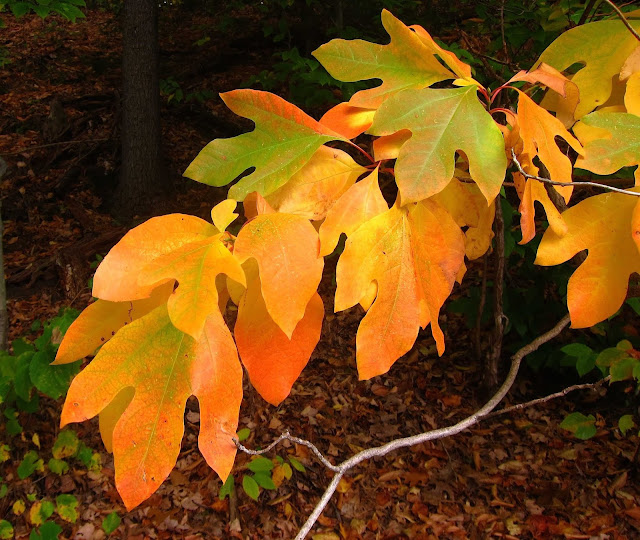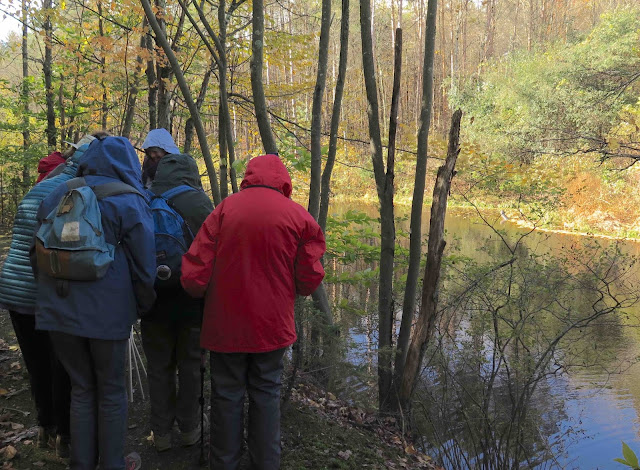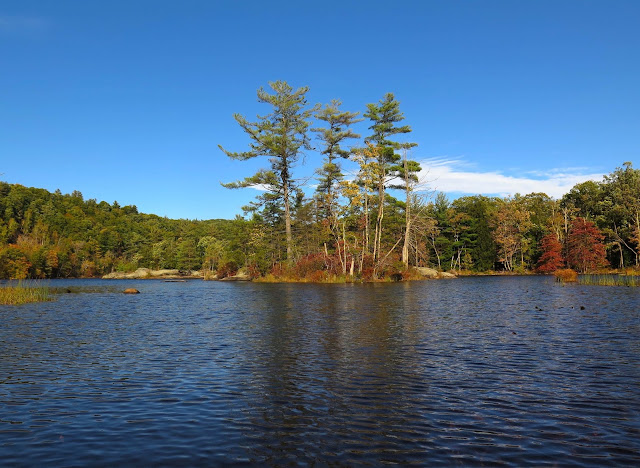Seems like it's been a while since we saw the sun. Rain again today, but just a little, and only off and on. Remembering my Mom's admonition from many years ago -- "You've got a raincoat. Go out and play!" -- I donned my Goretex and headed out. Maybe our autumn color had developed a bit more by now. Mud Pond at Moreau Lake State Park seemed like a good destination, and to get there I drove over Mt. McGregor and along Spier Falls Road where it runs close to the Hudson River. Here was my first view of the river. Made me mighty glad I decided to come out today.
When I got to Mud Pond, I was disappointed to see that the foliage on the mountains surrounding the pond was still rather drab, but the sapling Red Maples that line the trail were beautifully colorful.
And the seedling Red Maples were knock-your-eye-out vivid!
I next drove around to enter Moreau Lake State Park by the main entrance, stopping along the eastern shore of the lake to admire this colorful mountainside reflected in the still water.
I parked my car at the swimming beach and headed over the bridge toward the trail that would take me around the back bay. The Red Maples here were definitely coming into their glory.
I love this wooded trail that divides the main part of the lake from the back bay, especially in autumn, when yellow and ruddy leaves shed a golden light among the dark green pines.
Out on the sandy beach at the north end of Moreau Lake, the Black Huckleberry shrubs have begun their autumn spectacle. A deep burgundy red now, the leaves should develop their brilliant scarlet color in the weeks to come.
I was glad to see that some Sassafras saplings still held their multicolor leaves.
Can there be any purer yellow than of Striped Maple leaves in autumn?
Standing beneath a low-hanging Red Maple bough, I felt as if I were looking through stained glass.
Is green one of autumn's colors? Sure it is, when it's the evergreen leaves of Striped Wintergreen.
Heading back to my car, I took the road that runs through the woods, where I found a number of fascinating fungi. This jumbled mass is the fungus called Jelly Leaf (Tremella foliaceae).
I don't know of a common name for these slender greenish miniatures that grow at the base of conifers. The scientific name is Mycena epipterygia var. lignicola.
We have many different look-alike fungi that grow on dead wood, and I had to post this one's photo on a Mushroom ID site before I learned its name is Plicatauropsis crispa, also known as the Crimped Gill Fungus.
If you turn the Crimped Gill Fungus over, you can see how it got that common name.
Here's another fan-shaped, zonally striped fungus that grows on dead wood. Although it has achieved a brownish color by this late in the season, its name is Violet Tooth (Trichaptum biforme). When it first develops, it is edged with a distinctly purple tinge, which fades as the fungus matures.
When I turn this Violet Tooth fungus over, I can see the teeth that suggested that part of its common name.
I had to go back to that Mushroom ID site to try to learn the name of these overlapping caramel-colored discs. The most likely suggestion was Panellus stipticus, or the Luminous Panellus, so called because that species will glow in the dark. Darn it all! Now I wish I had brought some home, so I could put it in a closet and see if it glowed with a greenish light. That would clinch the ID.
This was such a plain mushroom when viewed from above, but look what a beauty it is when viewed from the underside, with those radiating gills.
I'm not sure if this chunky bracket polypore is covered with raindrops (it was raining a bit now), or if it was exuding drops of its own moisture, as some fungi are known to do, especially those of the Fomitopsis genus, which I think this may be. I just thought it looked quite interesting, protruding from the bark of a tree and dripping with crystal drops, next to some evergreen leaves of Pipsissewa.
These brownish balls are not really a fungus, although organisms like this one are usually included in mushroom guides. This is instead a slime mold called Wolf's Milk (Lycogala epidendrum). When fresh, it's colored bubblegum pink, but now it has faded to gray-brown as it ages and prepares to release its spores.
Here's the last fungus I found today, this salmon-pink, rather gelatinous growth I found spreading across a debarked log on the forest floor. It's called Phlebia tremellosa, with the common name of Wrinkled Crust. Apparently, according to what I have read, this is a commonly occurring wood-rotting fungus, although I have never come across it before.
This puckered piece of it (about an inch across) displays the wrinkled surface in which the wrinkles radiate outward from a central location. The spores develop on the surface of the wrinkles. The folded-over top edges that are evident in this colony are a distinguishing feature of this species of Phlebia.
I broke off a piece of the folded-over flap to examine it more closely, and I discovered this marvelously interwoven structure. Once again, I never know what I will find in nature, until I take a look.
For more than thirty years I've been wandering the woods and waterways of Saratoga County, New York, and regions nearby, looking closely, listening carefully, and recording what I experience. We are blessed in this region with an amazing amount of wilderness right at hand. With this blog I share my year-round adventures here, seeking out what wonders await in my own Madagascar close to home.
Tuesday, October 30, 2018
Friday, October 26, 2018
Ed Leads the Way!
To celebrate his 94th birthday, Ed leads the way along the forested trails of the Galway Nature Preserve.
Each week, my friends in the Thursday Naturalists choose some woodsy or watery or meadowy place to explore together. And this week, since it was his birthday, Ed Miller got to choose our venue: the Galway Preserve, a forested tract in the western region of Saratoga County. Wherever Ed might have chosen, we would have been happy to come along. Ed has volumes of botanical information to share with us, and now that he's 94 years old, who knows how many years we have left to delight in his company?
Ed's son Bill (tall man in the red coat) came all the way from California to celebrate Ed's birthday with the rest of his family, and we were honored to have him join us on our walk this frigid morning. As this photo shows, we came well bundled up against the cold.
It was windy, too, but our trail led us promptly into the woods, where the wind didn't reach us. We also warmed up as we strode briskly along trails that are well maintained by the land-conservation organization Saratoga PLAN. The Galway Preserve is one of many nature preserves this organization maintains throughout Saratoga County.
Of the options displayed on the trail map, we chose a loop that took us along the shore of a lovely pond, where benches were placed at several scenic locations.
I can't remember exactly what we were studying here, but I'm sure it was one of many fascinating finds that call us into nature, whatever the time of year.
Maybe it was this Wolf's Milk slime mold, also called Toothpaste Slime. Although its original bright-pink color had matured to this grayish brown, when we crushed one ball, we found it still filled with the pink pasty substance that earned it the "toothpaste" name. Like most slime molds, this specimen was not the least bit slimy.
It's also possible we were peering closely at a clump of Pink Earth Lichen, with tiny bubblegum-pink "lollipops" the size of a head of a pin.
Most of the fall fungi had faded by now, but this abundant clump of velvety, mink-brown Turkey Tail was still as lovely as ever.
The sight of this Paper Birch peering at us through some single-lensed sunglasses caused us to halt our steps and share a laugh.
We also did a double-take at the sight of this tree-trunk patterned like some enormous tropical python! I later learned that this pattern was created by a fungus called Giraffe Spot (Peniophora albobodia).
Although the foliage colors were not as brilliant as we might have hoped, this scattering of Lemon Drop "fairy cups" on the end of a log was bright enough to capture our attention.
The evergreen leaves and bright shiny fruits of Partridgeberry are as colorful as ever, whatever the season.
All in all, a most pleasant walk through a beautiful wooded landscape with delightful companions. Here, our friend Sigrin relaxes on one of the several benches positioned along the trail, enjoying the warmth of the sun as well as the serene beauty of the woodland pond. We then enjoyed a picnic, all together, seated at a rustic table surrounding a huge old Black Walnut tree and happy to share this special day with our dear friend Ed. I wish I had taken a photo of our friendly group, but my fingers were too sticky with birthday-cake frosting to operate my camera. Happy Birthday, Ed, and best wishes for wandering many more trails together.
Saturday, October 20, 2018
Muted Colors, Quiet Coves
The sky was blue, the sun was warm, the Hudson beckoned. It should have been a perfect day for a paddle on Friday, except for a wind that was whipping up whitecaps out on the open river. Ah, but I know a quiet place behind a river island where the wind hardly ever intrudes, so that's where I headed, carrying my lightweight canoe down through the woods to launch on water still enough to mirror the surrounding forested mountains.
I had hoped our autumn foliage would have grown more vivid by now. Perhaps it will yet come into its glory before the leaves shrivel and fall, but in the meantime I still found much foliar beauty here along the river banks. This low-hanging Witch Hazel shrub never disappoints, even though its leaves had only begun to achieve their maximum golden glow.
Most importantly, the Witch Hazel boughs were abloom with abundant flowers, the clusters of ribbon-like petals hanging low enough over the water that I could bury my nose in them and breathe in their subtle fragrance. I can only describe this fragrance as similar to the smell of clean laundry hung to dry in the sunshine and fresh air. Heavenly!
There are several deep coves along this section of the Hudson above the Sherman Island Dam, and here where the water lies dark and still, the muted colors of the surrounding trees were intensified in the reflections.
In the dark recesses of one of these coves, the bright-yellow leaves of Wild Sarsaparilla shone out from this boulder like beacons.
I did brave the gusts on the open river to reach a swamp that lies upstream behind this island pictured below. I've called this little island Three Pine for the tall White Pines that tower over its bouldered foundation. This swamp used to be ringed with mature Black Tupelo trees, before beavers managed to girdle their bark and kill most of them. The two reddish Black Tupelos pictured at the right side of this photo still remain, although the beavers have started gnawing away on their bark by now.
Compared to other years, when the tupelos' foliage has turned a glorious flaming red, the color of the leaves appeared darker than usual. But when I paddled beneath the boughs and observed the leaves from below, they glowed like stained glass against the bright-blue sky.
I was struck by how that bright sunlight lit up the wind-swept leaves of the Tussock Sedge that abounds in this riverside swamp. The dancing, swaying leaves seemed to just glitter against the dark shade of the background forest.
There's no better place than a swamp like this for finding Winterberry shrubs loaded with scarlet fruit, and I was not disappointed. Sure, the muted colors of our trees this year is kind of disappointing, but much else remains to startle us with beauty along the river.
I had hoped our autumn foliage would have grown more vivid by now. Perhaps it will yet come into its glory before the leaves shrivel and fall, but in the meantime I still found much foliar beauty here along the river banks. This low-hanging Witch Hazel shrub never disappoints, even though its leaves had only begun to achieve their maximum golden glow.
Most importantly, the Witch Hazel boughs were abloom with abundant flowers, the clusters of ribbon-like petals hanging low enough over the water that I could bury my nose in them and breathe in their subtle fragrance. I can only describe this fragrance as similar to the smell of clean laundry hung to dry in the sunshine and fresh air. Heavenly!
There are several deep coves along this section of the Hudson above the Sherman Island Dam, and here where the water lies dark and still, the muted colors of the surrounding trees were intensified in the reflections.
In the dark recesses of one of these coves, the bright-yellow leaves of Wild Sarsaparilla shone out from this boulder like beacons.
I did brave the gusts on the open river to reach a swamp that lies upstream behind this island pictured below. I've called this little island Three Pine for the tall White Pines that tower over its bouldered foundation. This swamp used to be ringed with mature Black Tupelo trees, before beavers managed to girdle their bark and kill most of them. The two reddish Black Tupelos pictured at the right side of this photo still remain, although the beavers have started gnawing away on their bark by now.
Compared to other years, when the tupelos' foliage has turned a glorious flaming red, the color of the leaves appeared darker than usual. But when I paddled beneath the boughs and observed the leaves from below, they glowed like stained glass against the bright-blue sky.
I was struck by how that bright sunlight lit up the wind-swept leaves of the Tussock Sedge that abounds in this riverside swamp. The dancing, swaying leaves seemed to just glitter against the dark shade of the background forest.
There's no better place than a swamp like this for finding Winterberry shrubs loaded with scarlet fruit, and I was not disappointed. Sure, the muted colors of our trees this year is kind of disappointing, but much else remains to startle us with beauty along the river.
Subscribe to:
Comments (Atom)


















































